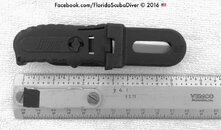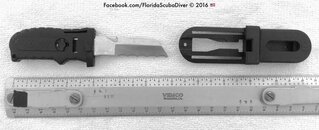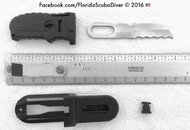Years ago I bought a stainless steel dive knife. It rusted.
A friend bought me another one as a gift. It rusted.
I bought a dirt cheap 'titanium-coated' dive knife as a Black Friday special. It rusted.
Sometimes trying to save money costs money. I will not diligently clean & dry knives after diving. Ain't gonna happen. Right up there with eating 'right' and going to the gym regularly, and all the arguments about why I should or how easy it is will not change that.
Which left either a pure titanium knife, or one of the H1 steel knives made by Spyderco (which also makes non-H1 knives, so watch what you buy). I bought a
Spyderco Salt 1 H1 steel knife on Amazon for a bit over $60.
It sits in a little accessory pocket on the outside of my BCD pocket on a Sherwood Avid BCD. I don't rinse it unless I dunk the BCD or it's the end of the dive trip. Bonaire. 2 Live-aboards. Plenty of time in salt water. It's done fine. From experience and some digging, a couple of interesting points:
1.) Someone pointed out that they use a drill bit with a different kind of steel to carve their symbol into the blade, and you may see trace rust there because of residue from that drill bit. Well, if you look close at my knife, you can see a faint orangish color right there.
2.) While rust-proof, I'm told you can corrode one if you want. They're too expensive for me to play like that, but I've read someone put one in a bucket on a solid chlorine tablet (sold for chlorinating swimming pools), and while not technically rusting, it did significantly corrode the blade. Assuming that's true, you could damage H1 steel if you wanted to. I've never heard anybody complain about pool or tap water chlorine causing problems.
In Scuba Labs 2015 Dive Knife review,
they included the Spyderco Salt Assist and had this to say:
"The newest of Spyderco’s Salt line made of H-1 steel — which in our experience lives up to claims that it’s impervious to rust — is less than 5 inches long. It opens to 8.5 inches with a flick of the thumb (even with 5 mm gloves). The waffle grip is extremely effective, and the handle offers excellent control (although it might be a bit much for small hands). With a cutting edge 3.2 inches long, the blade sliced through all of our test lines like a light saber, and its rounded tip lets you slip the blade in between what you’re cutting and what you very much don’t want to cut. The handle has a carbide tip to break glass or ice, and a safety whistle. Sharp, safe, handy and rustproof, the Spyderco Salt Assist is our Testers Choice in the large-knife category."
One point of criticism of my Salt 1 - it came as a folding knife with no sheath, and if I didn't have that little pocket on my BCD, I'd have had to dream up some way to attach it.
Richard.
P.S.: Also bought a Trilobyte and like it; it rusts, but not real fast, and it's so low profile you can forget it's there. Interestingly, Dive Gear Express now has the
DGX Sharp Cut, with a ceramic blade that if I understand correctly isn't supposed to rust. Looks to me like a Trilobtye, and it's inexpensive.







